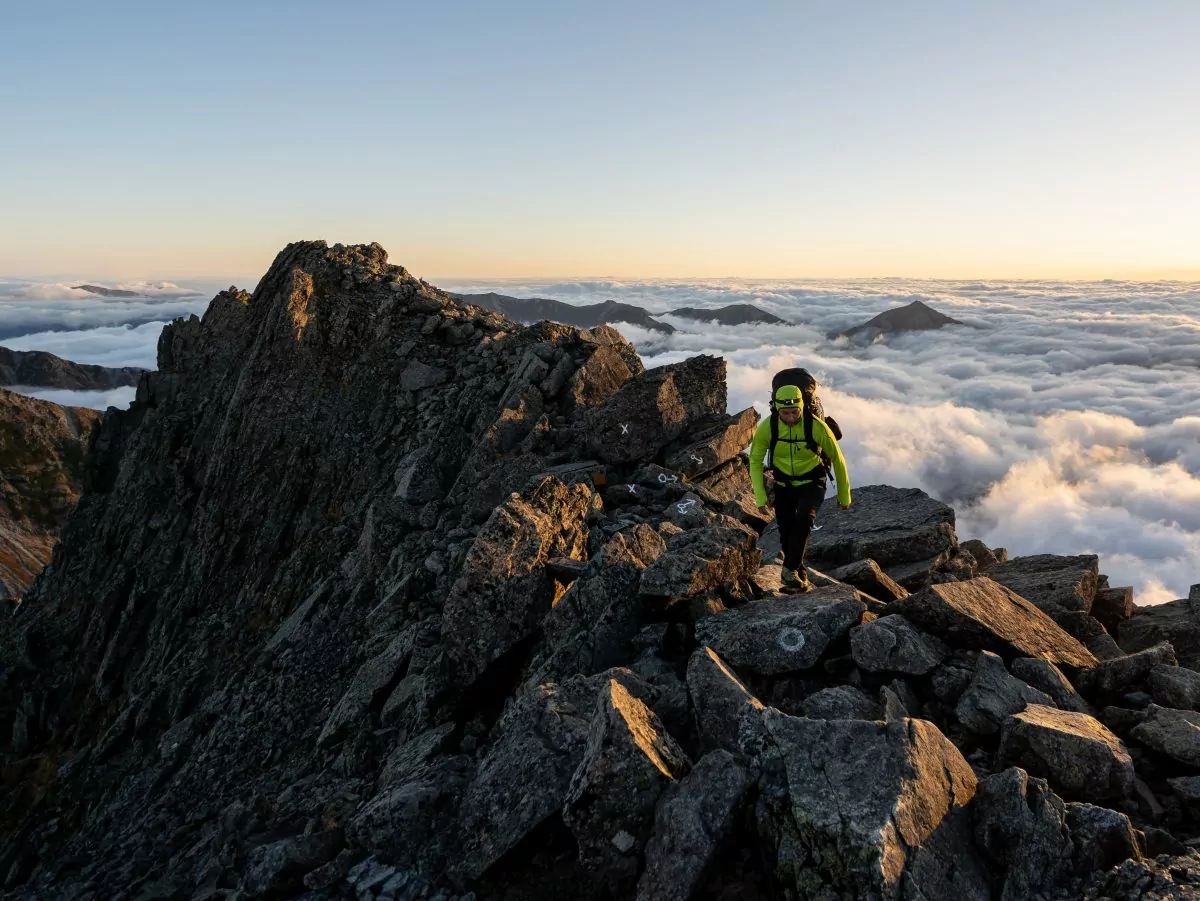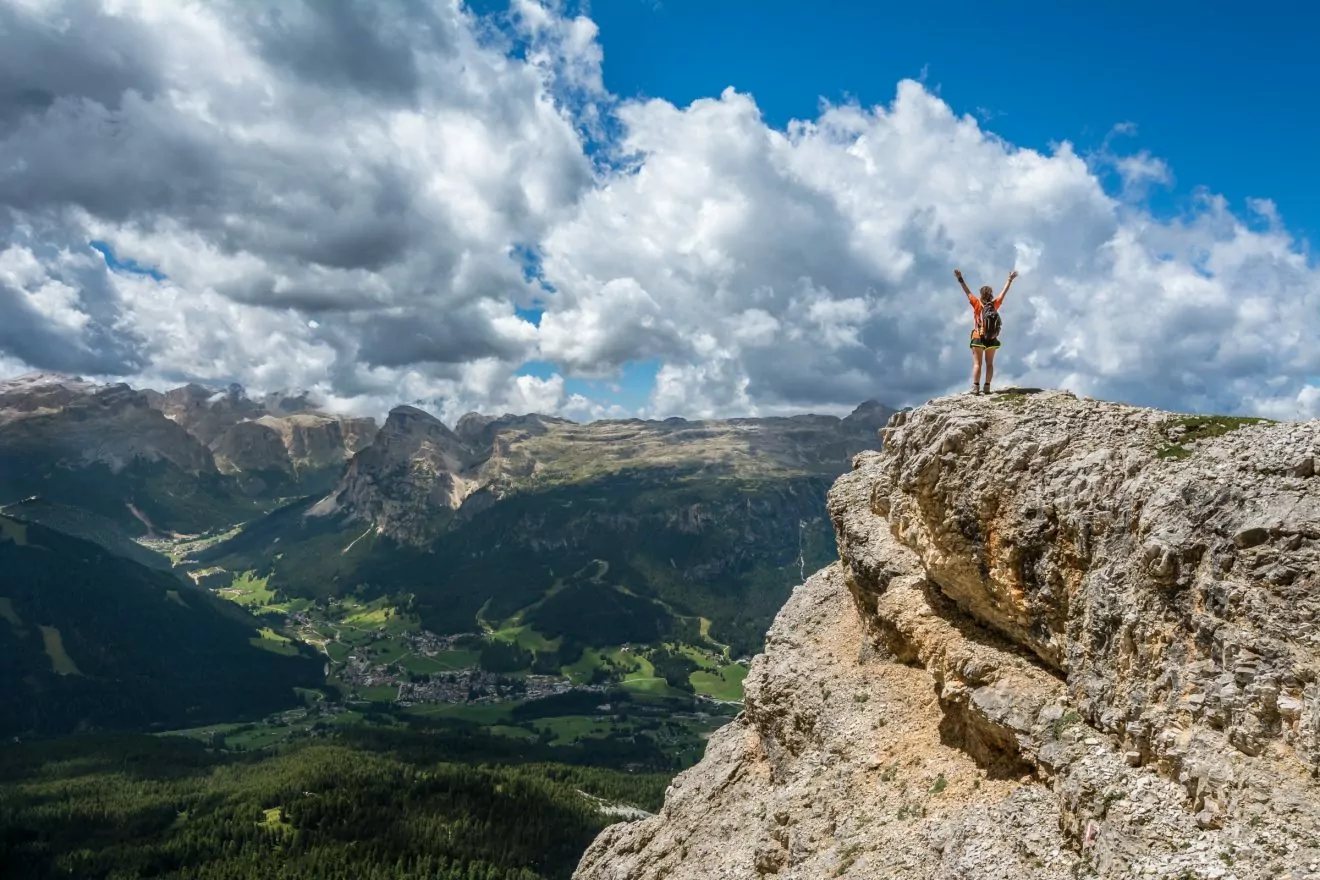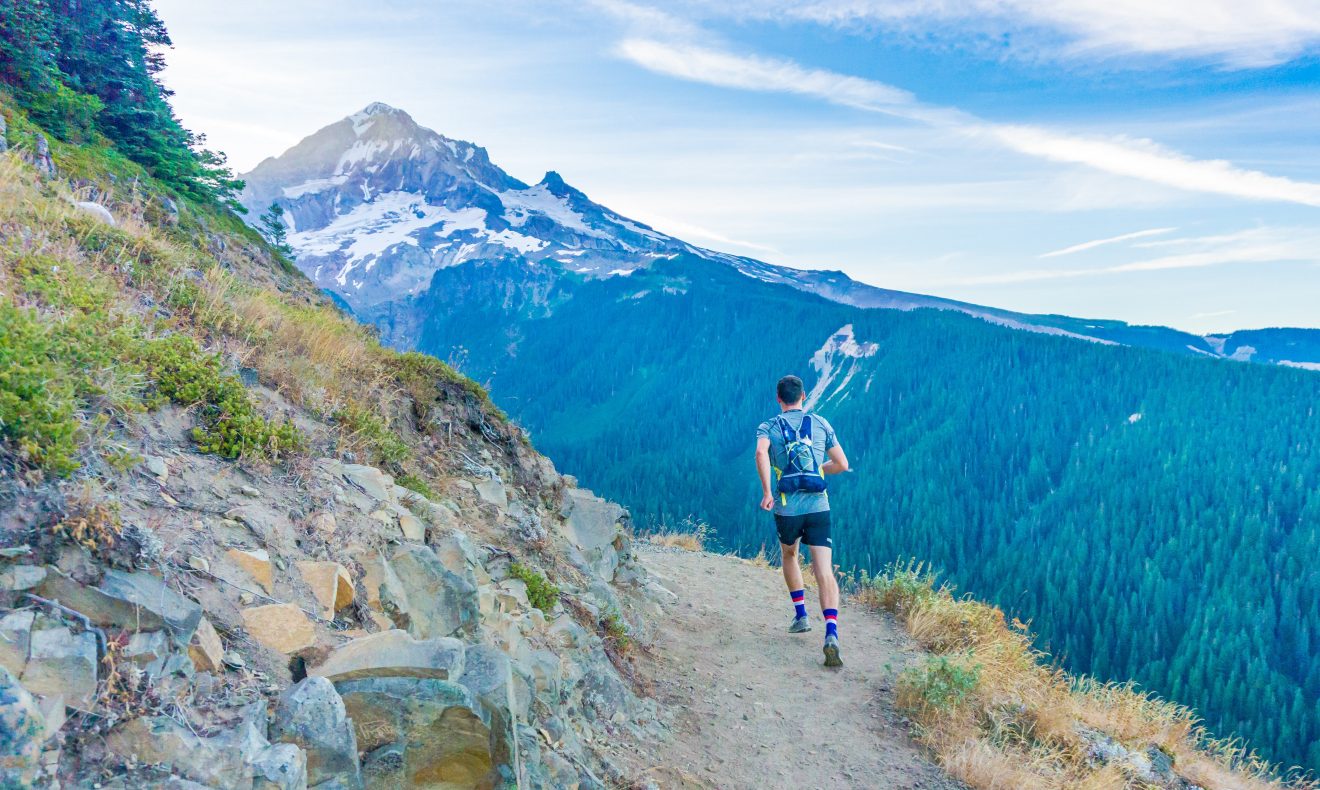
Training for backpacking and hiking shouldn’t just involve physical exercise (although physical training is a crucial element!) For many hikers, the hardest aspect of backpacking is the mental game. If this sounds like you, you might want to consider mental training for hiking.
Imagine this: you’re thrown out of your comfort zone and into the wilderness with a 30lb pack on your back. Your plan is to walk — all day. In fact, that’s really the only thing you’ll be doing. You keep putting one foot in front of the other, slow and steady, for hours at a time. The rhythm allows you to focus on your thoughts. And oh boy, do they flood in. “Is that knee pain I feel?” you wonder. “Wow, it is hot out here today.” “We still have two thousand feet of elevation to go?? And how many miles?” These thoughts cycle on repeat in your head. “I can’t do this,” you tell yourself. At some point, your inner child kicks in and you let out a sigh, “Are we there yet?”
But of course, we get out on the trails for a reason. The rewards of hiking and backpacking are well worth all the hard work and discomfort. Not only can you access some of the most fantastic environments, but you also find out what your body is capable of. Each night when you drop your pack at camp (or at the car), you can’t help but smile at your accomplishments. It feels good to work hard… afterward.
However, the more you prepare — both mentally and physically — the more you’ll enjoy the entire process. We promise, it’s possible. Type 2 fun (the kind where it’s only fun after the fact) becomes regular, old fun. Your nagging negative thoughts shift to positivity, your energy levels stay high, and your body feels fresher after each long day on the trail.
Luckily, you can train mental strength. We’ll cover a few tips and tricks for mental training for hiking and backpacking.
WHAT IS MENTAL TOUGHNESS, ANYWAY?

Mental toughness is the quality that allows people to persist in the face of difficulties. It is a crucial aspect of human performance, in sports and everyday life. Some people call it grit, resilience, or willpower. If you exhibit mental toughness, you might show a few qualities:
- You see challenges as opportunities.
- You don’t stop when things get difficult; you’re committed to seeing your goals through to the end.
- You have confidence in your abilities to finish a task.
- Your internal self-talk is overwhelmingly positive.
MENTAL TRAINING ISN’T JUST FOR ELITE ATHLETES
Mental training emerged in the sports psychology, but the concept is so powerful it shouldn’t only be reserved for elite-level athletes. In fact, anyone can benefit from mental resilience — from the most casual day hiker to a backpacker getting out on a long-distance trail. You can train mental toughness on and off the trail — and we’ve compiled a list of tips below for both training and putting it into practice. This way, when you set out on your next adventure, your brain will support you instead of working against you.
Pro Tip: If you’re interested in learning more about the elasticity of human limits, check out the book Endure by Alex Hutchinson!
MENTAL TRAINING FOR HIKING AND NEUROPLASTICITY
John Kennedy, owner of Combat Brain Training, is an expert in mental training. He’s worked with military members, athletes, and business owners to improve brain function and mental capacity. But compared to the traditional psychological approaches, Kennedy uses a physiological method to improve the brain’s ability to make sensory connections: neuroplasticity training.
At the most basic level, neuroplasticity is the capacity of our brains. It impacts everything we do. “When you practice something over and over again, your brain is changing to be able to better perform that action in the future. The conscious becomes unconscious,” Kennedy says.
Brains change from resistance. “Instead of affecting muscle fiber, brain training increases post-synaptic receptors. As you improve, more neurons pass through the brain in the same amount of time,” Kennedy explains. “If you want to change a behavior, you have to create the pathway and repeat it enough times so that becomes your new habit, your new ‘zombie system’ (an unconscious reaction rather than a meticulously thought-out action).” And our brains are incredible at adapting. When you begin neuroplasticity training, you begin to see improvements very quickly. After 20 minutes of practice, your brain is physically changed.
So how does neuroplasticity training translate to hiking and backpacking? Well, you can expect faster reaction times, better focus, and more of a flow state while you’re hiking. When you’re more mentally efficient, you’ll get less exhausted from simple tasks because they don’t take as much mental energy. (This is HUGE in backpacking!)
Neuroplasticity training is a bit different from mental toughness training — but they complement each other. The psychological methods of training — like most mental toughness training — work because of neuroplasticity. “The psychological elements – how you feel about yourself and others – are like the operating system. The best way to improve the operating system and all the applications immediately is to get a new computer because the processor is faster. Once you have a new processor, your operating system will run more efficiently,” Kennedy explains.
The best plan of action? Implement both into your training. So, we’ve broken down how to do just that.
MENTAL TRAINING: PREPARING FOR BACKPACKING OR HIKING
If you want to maximize your abilities on the trail, you need to put some practice in before the big event. Here are some exercises and tips to try:
1. NEUROPLASTICITY ACTIVITIES
If you’re not ready to fully dive into neuroplasticity coaching with a trainer like Kennedy, you can practice a few simple activities at home to improve your brain function. Here’s one example that Kennedy explained:
“Take a book or magazine. (It shouldn’t be on a screen!) Start reading down the page and when you get to the end of a paragraph, notice the last word. Instead of saying the last word, say a number. You’re training your brain to look ahead, and execute. Your goal is to see the word, and unconsciously say the number instead of the word.” If you have the hang of the basic drill, you can make it more challenging by reading backward or using colors instead of numbers.
The point of this activity? “Your brain will learn to process information differently because you’re using different parts of the brain and enhancing connections between them.”
Kennedy mentions one key approach to neuroplasticity drills: don’t stop for mistakes. “We have a compulsion to stop for distractions, which breaks the momentum. If you don’t have to stop for mistakes, it helps you keep momentum,“ Kennedy suggests. “If you get your head out of the game because of a small mistake, it takes you that much further to get back. But if you don’t dwell on it, then you can keep going and address it at the appropriate time.” This idea translates to other activities, like hiking. So next time you make a small mistake while you’re backpacking, just keep going and don’t break your focus.
2. VISUALIZATION
Visualization is the practice of using all your senses to run through a scenario before it happens. Elite athletes use this technique before events, but it has been increasingly used by life coaches to help clients meet their goals.
Ramsey Bergeron, a certified Scottsdale-based Life Coach and Personal Trainer who guides adventure retreats, suggests using visualization techniques before a big backpacking trip. “If you’re going to do a couple of days in Bryce Canyon, visual what it will be like to be out there.”
Close your eyes and envision yourself hiking in Bryce Canyon. What do you see? What does it smell like? How do you see yourself hiking through the landscape? Include as many details as possible, and maintain a positive perspective.
“I’m doing Rim to River to Rim soon, so when I’m hiking in Phoenix, I’m visualizing hiking up the Bright Angel Trail.” Once you complete the exercises, write down what you learning and what you’re planning on implementing.
3. REPLICATE YOUR HIKING EXPERIENCE AT HOME
You can’t replicate your entire hiking experience at home, but you can piece together the important elements to get ready for your big trip. For example, Bergon wakes up to hike at 3 AM to prepare for his Grand Canyon trip. He does this because he knows that’s what he’ll need to do on the trail. “If you know you’ll wake up to hike on your trip, wake up to hike at home so your body will know what to expect.”
You can prepare for other aspects of your trip, too. Bergeron recommends practicing how you’re storing food and how you have the gear organized in your pack. “Nothing sucks worse than being on a multi-day hike and tearing through your pack to find lip balm at the bottom. Having an organization system really helps you so you have more time to focus on what you came there to do.”
All this practice will help you feel confident when you set out on the trail. “Confidence can make a break a hike,” Bergeron says, “So give yourself the best chance of success by replicating conditions ahead of time.”
4. ESTABLISH A BENCHMARK TO MEASURE YOUR PROGRESS
“Find a benchmark to measure your progress – it should be a more challenging hike in your area,” Bergeron recommends. “Hike it at the beginning of your training. Even if you don’t make it all the way, that’s fine. Then, come back to it near the end of your training.”
This benchmark will serve as a motivational tool for your physical training (which is not the type of thing you can cram in, Bergeron mentions), but it has powerful mental benefits, as well. When you return to your benchmark at the end of your training, your confidence will skyrocket as you measure your improvement.
JOIN A GUIDED BACKPACKING TRIP
MENTAL STRENGTH: TIPS FOR THE TRAIL

Once you’ve prepared for your backpacking trip, you get the chance to put all your training into action. Use a few of these tips to maximize your efforts on the trail and stay mentally strong during a long, hard day of hiking!
1. SET AN INTENTION
When things get tough, it helps to know your “why.” Bergeron recommends diving into this topic both before you go on a hiking trip and while you’re on the trail. “Ask yourself, ‘Why do I want to do this?’” he says. “If you’re there to enjoy nature, maybe you don’t have to push so hard. If you’re there to challenge yourself, then embrace that. If you’re there to connect with friends you haven’t seen in a while, then focus on those connections.” Let the intention guide your trip so you fully embrace the experience.
2. BREATHE
Scientists have been touting the benefits of meditation for years now, but you can simplify this practice to keep your mind engaged during particularly tough stretches of the trail.
If you begin to get bogged down by your thoughts, start to count your breaths. Three breathes in through the nose, hold at the top, then exhale for three breaths. As this becomes easier, lengthen your inhalations and exhalations. Not only does breathwork help to focus your mind and lower your heart rate, but nose breathing is also a fantastic skill for endurance activities.
3. AVOID NEGATIVE SELF-TALK WITH KEYWORDS
Negative self-talk happens to the best of us — and it can be really hard to overcome. “Whenever someone gets stuck in that negative mentality, they stop looking for solutions,” Bergeron explains. “But instead of seeking self-improvement, practice self-compassion. If we talked to people the way we talk to ourselves, we wouldn’t have any friends.”
His number one tip: don’t beat yourself up. “All that does is keep you going down that shame spiral. Most people don’t go on multi-day hikes, so be kind to yourself.”
But if you’ve ever tried to use self-compassion, you know it can be difficult. So, you need tools you can use in these circumstances. Kennedy offers one solution. “When you have a behavior you want to change, insert a keyword for the desired habit. Then, remember to say the keyword to build the habit.” This has a physiological effect — you change the pathways in your brain.
So, next time you’re hiking and the negative chatter creeps in, choose a keyword to encourage positive self-talk. (Just like a mantra or positive affirmation.)
Or, if you’re more of a visual person, Bergeron explained another exercise that can help shift your mindset. “When was the last time you felt you couldn’t do something and then did it? Visualize a time in your life when you were challenged. What worked well in that situation and how can you apply that here?” This practice reminds you that you’ve overcome challenges in the past, so you are capable of doing it again.
4. SET SMALL GOALS
Instead of focusing on all of the work ahead of you, set small incremental goals to break up your day. If you encounter multiple trail sections over the course of a day, set designated checkpoints to instill a sense of accomplishment. Maybe you use the red arrows on your topo map, or you use landmarks like stream crossings. Maybe you just set your attention on your next break spot. If you’re really fighting with your mind, you can set even smaller goals – like getting from one tree or rock to the next. By setting small goals, your larger goal for the day will feel much more achievable.
5. JOURNAL
Keeping a journal is a great way to reflect on your day’s events during a backpacking trip or after any challenging day. “After the hike, reflect on how your day went. Don’t think, ‘I’ll remember, I don’t have to write it down.’ Grab your journal and write down what went well over the course of the day so you can replicate or change it for next time.” Bergeron notes.
THE IMPORTANCE OF TRAINING
Many hikers and backpackers know the importance of physical training before a big goal, but few focus on improving their mental abilities. Use these tips next time you’re prepping for a trip or hitting the trail, and let us know if they help!

No comments:
Post a Comment